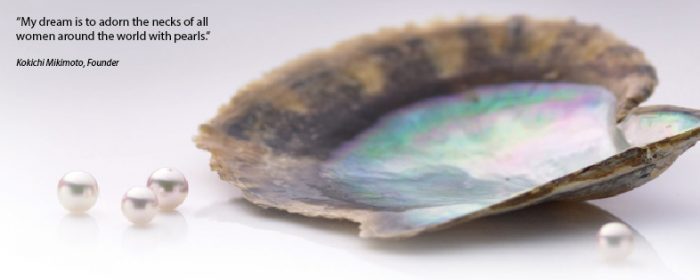
Download this article
Ancient cultures considered natural pearls to be ‘tears of the Gods’. They were believed to bestow mythical powers and wisdom to whoever possessed them. In today’s society the cultured pearl is considered the ‘stone of sincerity’ and represents purity. It symbolises the birthstone for June and the third and thirtieth wedding anniversary. Jackie Kennedy once said ‘Pearls are always appropriate’.
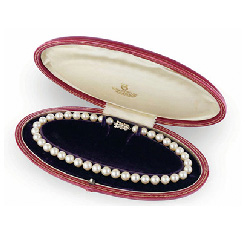
A set of cultured pearls gifted to Marilyn Monroe in 1954 by Joe Dimaggio
Yet for many years pearls have fallen out of fashion, with people associating them with their grandmothers and the older generation. However, as with the cyclical nature of all things, pearls are now enjoying a renaissance. Iconic women such as Michelle Obama can be seen wearing both a classic cultured pearl necklace as well as more contemporary cultured pearl set jewellery. The Duchess of Cambridge often sports a pair of cultured pearl earrings.
Cultured pearls are making a comeback but not just in the traditional sense of the simple necklace and stud earring set. The classic string of cultured pearls, such as the set gifted to Marilyn Monroe in 1954 by Joe Dimaggio (pictured), will always have a place in our hearts, however we appear to be moving away from the need for a string of perfectly round pearls and contemporary designers are embracing the irregular shapes of baroque pearls to make innovative and unique pieces. Freshwater cultured pearls such as the fireball are being combined with diamonds and gems to make beautiful, abstract creations.
The production of pearls is a fascinating business. Whether the end product is perfectly round or completely irregular in shape the process is the same.
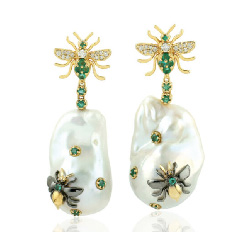
When it happens naturally a ‘foreign body’ invades the mollusc and as a way of protecting itself the mollusc secretes nacre. Gradually layer upon layer of this lustreous substance containing microscopic crystals of calcium carbonate, covers the ‘foreign body’ and a natural pearl is formed. When it happens artificially and a piece of mantel tissue or bead nucleus is inserted into the mollusc the pearl is cultured.
It’s of little wonder that before Mikimoto commercialised the cultured pearl industry in the late nineteenth century, pearls were only accessible to royalty and the very rich. This is because of the many mollusc varieties known to us only a small number can produce pearls. Of the pearls that they produce only a small number will be of a desirable shape, colour and quality, and only a fraction of these will actually be discovered by man. Consequently natural pearls are extremely rare and very expensive.
So how can you tell the difference between natural and cultured pearls? If you take a look at the drill hole you may be able to see the bead nucleus of a cultured pearl. A factor in the value of natural pearls is weight, so the drill hole tends to be a lot smaller compared to cultured pearls. Also a string of naturally formed pearls will tend to be slightly mismatched and irregular in shape, they will be smaller and almost always graduated. However to be absolutely sure the pearls need to be sent to a laboratory for certification, where they will be x-rayed.
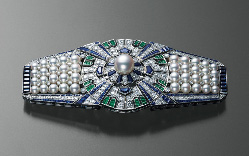
In 1937 the Yaguruma, a sash clip with interchangeable settings in 12 different forms, attracts crowds at the Paris Expo. Its unique design is a breakthrough in multi-functional jewellery. Sold in Paris, it disappears from public view, then reappears at an auction in New York in 1989. It is purchased by Mikimoto Pearl Island where it remains today.
There are many different types of cultured pearl but they fall into two categories and are either saltwater or freshwater.
Freshwater cultured pearls are cultivated in mussels, in lakes and rivers. Mantle tissue from another mussel is often used to start the process and this is why they are often irregular in shape. However bead nucleation is becoming more and more common in order to cultivate larger more rounded pearls. Up to forty freshwater cultured pearls can form within a single mussel, making them more readily available on the market.
To cultivate saltwater cultured pearls is a slightly more labour intensive process. They are grown in a variety of oysters. Often just one pearl per oyster, using both mantle tissue and a bead nucleus to produce a more round pearl.
There are three main types of saltwater cultured pearls: Akoya, South Sea and Tahitian. Akoya cultured pearls are farmed in Japan, China and Vietnam. They are usually white and cream in colour and measure from 2mm to 11mm.
South Sea cultured pearls are grown in Australia, Indonesia and the Philippines. They come in shades of white, silver and gold and typically measure from 8mm to 20mm.
The Tahitian cultured pearl are cultivated in French Polynesia and The Cook Islands. They are much darker in colour, blacks, greys and browns and measure from 8mm to 18mm.
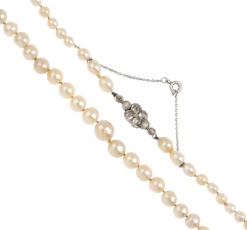
This natural pearl and diamond necklace was recently valued for the purpose of insurance at £10,000.
Pearl jewellery is often passed down through generations and many people are unsure if it is natural, cultured or imitation.
When we consider that cultured pearls have gone up in value by approximately 10% over the last 5 years, and South Sea cultured pearls have gone up even more significantly, the question is, does your inherited pearl necklace have an accurate, up to date valuation and is it properly insured?





